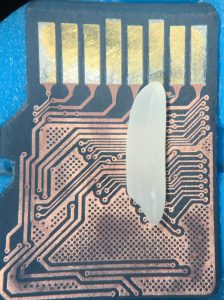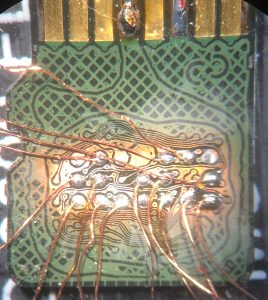Monolithic device data recovery or 'chip off'
Older standard USB flash drives and secure digital cards contain a printed circuit board with components and chips joined by tracks on the circuit board. Although these components and tracks are small they’re visible and can be removed and swapped in order to repair a damaged device. Monolithic devices have all of their component parts built onto one integrated circuit board and then encased in a protective material. There’s nothing for us to repair to get your device working again. As all of these formats work on the same protocol many modern devices are now just empty shells containing microsd cards. The outer casing is there just to change the physical shape to suite the device it will be used in. Nearly all devices are now monoliths.
Is your device a monolith device.
It’s not always easy to tell if your device is a standard or monolith without opening the case, however there are few signs which will give you an idea.
- Physically small usb drives like the Sandisk Ultra Fit and PNY Mini.
- Thin drives like Transend Jetflash 710 or Kingston Datatraver SE9.
- A retaining bar on the bottom of the USB connector.
- All micro SD cards.
- Most modern high capacity SD Card or USB Flash Drives.
Recovering data
It’s possible to recover data but it requires extensive time under the microscope. We must remove the protective coating and piggyback the connections by soldering a dozen or more very thin wires onto very small contact pads directly on the device. We can then use these connections to extract the raw data from the chips and rebuild your files using professional data recovery software.
Extracting data this way takes considerable time and skill, the photographs opposite show two monolith that have been prepared for data extraction with a grain of rice for scale.
Recovering raw data from these chips via the NAND protocol is a multistage process, once wires have been soldered to the correct pads the transfer of the data from a monolith may take a considerable amount of time. This will depend on the capacity and condition of the card, A healthy Sandisk 200GB mSD will read at 4MB/sec and will require about 20 hours of continual reading to extract the data, under normal conditions in your equipment these cards would operate at 90 MB/sec.
Once extracted the low quality QLC memory chips used to produce modern cards require another 20 hours to run error correction known as ECC. This code is used to fix data that has been read incorrectly but there is enough data present to be corrected by an algorithm.
After this processes any block that still have error will need to be read again using read retry processes where voltage levels are altered to provide the optimum reading patterns. Rereading a card that is in a poor condition like this can take weeks.
Additional complexity
Unfortunately there are no standards for card connections, each manufacturer has a different layout between device types and even versions of the same device. Unless we have the connections already in our databases the only way to determine the layout is via a logic analyser. The increases in labour and equipment costs to do this means it’s normally not financially viable to do this.
Although most cards use an ECC algorithm for data integrity and increasing number of cards are using LDPC ( Low Density Parity Check ) as yet these have not yet been reverse engineered and cards using these are usually unrecoverable do to the poor read quaility.
Service Availability
Not all data recovery companies offer NAND chip off services. The process requires different types of tools, a different skill set and different equipment to standard drive recovery and considerable time microsoldering. With all the additional requirements and the length of time that is need for each case many companies have chosen to subcontract this type of recovery to others and we provide NAND chip-off recovery services to a number of other data recovery companies.

